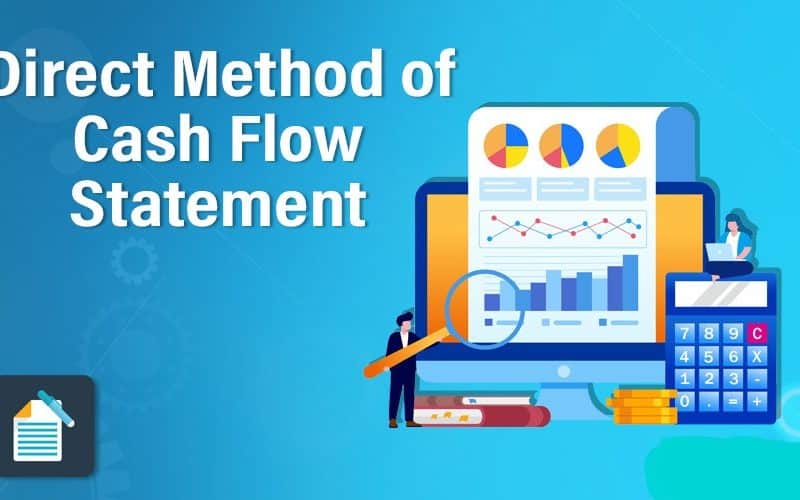What is the Direct Method, and how does it work?
One of two accounting practices for generating a cash flow statement is the direct approach. However, instead of converting the operating segment from accrual to cash accounting, the statement of cash flows direct method uses real cash inflows and outflows from the company’s activities. Revenue is recognized in accrual accounting when it is paid rather than when it is collected from a client.
The cash flow direct system, on the other hand, calculates only the cash collected. This is usually from consumers, as well as the cash payments or outflows, such as to suppliers. Basically, the cash flow is dependent on netting the inflows and outflows. The income statement form is another name for the direct method.
Understanding the Direct Method of Preparing a Cash Flow Statement
The balance sheet, income statement, and cash flow statement are the three major financial statements. The cash flow statement is broken down into three categories; operating cash flow, financing cash flow, and investing cash flow. Its preparation is in one of two ways: directly or indirectly. Both the indirect and direct methods would provide the same cash flow from funding and investing activities.
The indirect method of estimating cash flow from operations relies on accrual accounting data. It often starts with the income statement’s net profit.
To calculate cash flow from operations, you’d need to adjust the net income for changes in the asset and liability accounts on the balance sheet by adding to or subtracting from net income.
The only part of the statement of cash flows that may vary in presentation under the direct approach is the cash flow from operations section. The cash receipts and cash payments made during the accounting period are listed using the direct method. Therefore, t o measure the total cash flow from operating projects, deduct the cash outflows from the cash inflows, then add the net cash from investing and funding activities to get the net cash increase or decrease in the business for that period of time.
Before we go any further, let’s deviate a little into the accrual concept. This will help us get a grip of this method properly.
What is the Accrual Concept, and how does it work?
The accrual accounting principle, also known as accrual accounting, is an accounting method that specifies the accounting of financial components of an entity as and when they occur. This means that they go into records when profits are obtained and/or expenditures are incurred, rather than when the payment for that transaction is collected or rendered and the actual inflow or outflow of cash occurs.
The accrual approach differs from the cash accounting method, which requires an institution to report financial transactions not when revenue is generated or expenses are incurred, but when the actual cash inflow or outflow for the transaction occurs.
The cash flow statement direct approach recommends using the cash accounting principle rather than the accrual accounting concept.
Major complexities of the Direct Method
The indirect method is preferred and more widely used due to the complexity and time needed to list all cash disbursements and receipts, which is required for the direct method. Business operations are reported on the balance sheet and income statement in accordance with the accrual form of accounting, which is used by the majority of businesses.
For example, if a business uses accrual accounting, sales revenue would be reported on the income statement in the current year even if the transaction was made on credit and the buyer has not yet paid. The same sum will appear as accounts receivable on the balance sheet. Companies who use accrual accounting do not collect and store transactional data on a cash basis for each buyer or supplier.
Another disadvantage of the direct approach is that the FASB allows a company that uses it to document the reconciliation of net income to cash flow from operating expenses. Ordinarily, these would have been disclosed if the indirect method had been used to prepare the statement. The reconciliation report is similar to the indirect report in that it is used to verify the accuracy of operational activities. The net income is listed first, followed by adjustments for non-cash transactions and changes in the balance sheet accounts. The direct approach is controversial among businesses because of the additional activity.
Examples of a Direct Method
The following are some examples of the direct method for the statement of cash flows in the operations section:
- Payment of Salaries to employees
- Dividends and interest income
- Payment to Vendors and suppliers
- Payment from Customers
- Income Taxes and interest Payments
This method of listing details gives the recipient of a financial statement a more accurate view of where a company’s cash came from and how it was spent. As a result, the Financial Accounting Standards Board (FASB) advises businesses to use the direct approach.
The statement of cash flows direct process, despite its drawbacks, records the direct sources of cash receipts and payments, which can be useful to investors and creditors.
Operating Section Format
The income statement method is another name for the direct method. The direct method, in writing, follows the format below:
Cash Flow from Revenue
Cash Payments for Expenses
= Gross Income Before Taxes
Payment of Income Taxes in Cash
= Net Cash Flow From Operating Activities
The first two line items, cash flow from sales and cash payments from expenditures, are both affected by the complexity issues mentioned earlier.
This is an example of what you might come across. Assume you’re keeping track of all your payments to suppliers over the course of a year. You must retain the same level of detail in the other accounts that such payments impact. This includes inventory accounts payable and cost of goods sold, in addition to keeping a high level of detail for that account. Even though the Financial Accounting Standards Board (FASB) prefers this approach, few firms can handle all of the transactions it entails.
Format of the Operating Section: Indirect Method
The indirect approach needs three sources of data to prepare the Statement of Cash Flows. This includes two years of comparable balance sheets, the latest income statement, and the general ledger.
It’s pretty simple to measure net cash from operating activities using the indirect approach. You subtract depreciation from net sales on the income statement. The adjustments in current assets, current liabilities, and other sources (e.g., non-operating gains/losses from non-current assets) are then reported on the comparative balance sheet. The net cash flow from operating activities is now complete.
Using the Direct Method vs. Using the Indirect Method
The indirect method of preparing a cash flow statement is the most common. It’s because most companies around the world adhere to international accounting standards and GAAP (Generally Accepted Accounting Principles). It mandates the use of the accrual rather than cash accounting methods.
What Is the Difference Between Direct and Indirect Method of Cash Flow?
The direct cash flow method begins with cash transactions, such as cash received and cash paid, and disregards non-monetary activities. The indirect cash flow method, on the other hand, begins with the net income and then adjusts for the remainder.
What Is Direct Method Example?
The major cash payments and cash receipts from the direct method are shown on the statement of cash flows. For example, cash from customers, commissions, and renters are often listed. Cash payments are usually split into several groups, such as payments for inventory, wages, rent, taxes, and interest.
What Are the 3 Types of Cash Flows?
There are 3 types of cash flow.
- Operational cash flow.
- Investment cash flow.
- Financing cash flow.
Conclusion
It’s almost impossible to go through preparing a cash flow statement without the having an idea of both methods. As you may have noticed, at some point, you would need one of these methods. So, here’s my advice; get aquainted with both methods to avoid getting stranded at any point.
- Cash Flow Forecasting Software: Best 7 Options in 2023 (+ Free Template)
- Diversification Strategy: Overview, Examples, Types, Pros & Cons
- Finance Documentaries: Best 10 Listing for Newbies & Pros (Updated)
- Net Asset Value: Calculations, Formula, Calculator, & Quick Guide
- ACCRUAL ACCOUNTING: A SIMPLIFIED GUIDE FOR BEGINNERS (+Detailed examples)
- CASH FLOW: All you need to know, Simplified!!! (+ Free format)
- FINANCIAL REPORTING: All you need to know with Examples (+ quick easy tools)
- FINANCIAL ANALYST: Meaning, Requirements, Skill, Salary, ( +free Employment tips)






